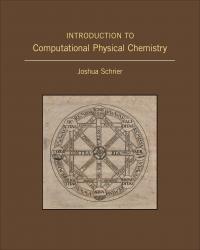Introduction to Computational Physical Chemistry
Introduction to Computational Physical Chemistry
By: Joshua Schrier
This book will revolutionize the way physical chemistry is taught by bridging the gap between the traditional "solve a bunch of equations for a very simple model" approach and the computational methods that are used to solve research problems.
For all sales outside of the United States, please contact Felicity Henson, fhenson@aip.org
Title information
This book will revolutionize the way physical chemistry is taught by bridging the gap between the traditional “solve a bunch of equations for a very simple model” approach and the computational methods that are used to solve research problems. While some recent textbooks include exercises using pre-packaged Hartree-Fock/DFT calculations, this is largely limited to giving students a proverbial black box. The DIY (do-it-yourself) approach taken in this book helps student gain understanding by building their own simulations from scratch. The reader of this book should come away with the ability to apply and adapt these techniques in computational chemistry to his or her own research problems, and have an enhanced ability to critically evaluate other computational results. This book is mainly intended to be used in conjunction with an existing physical chemistry text, such as McQuarrie & Simon’s Physical Chemistry: A Molecular Approach, but it is also well suited as a stand-alone text for upper level undergraduate or intro graduate computational chemistry courses.
-Assumes no computational background.
-Enables students to build simulations from scratch to reproduce famous literature calculations.
-Teaches a variety of computational/numerical/simulation methods, applicable to solving chemical problems.
-Designed to “play well” with McQuarrie & Simon’s landmark P CHEM text, but can be used with others as well.
Preface
To the Instructor
To the Student
Syntax Coloring Conventions
PART I. QUANTUM MECHANICS
1. The Particle in a Box
2. The Finite Difference Method: Bound States
3. The Finite Difference Method: Tunneling
4. Variational Method
5. Hartree-Fock Self-Consistent Field
6. H ¨uckel Molecular Orbital Theory
7. Quantum Theory of Solids
8. Density Functional Theory
9. Quantum Monte Carlo
PART II. THERMODYNAMICS AND KINETICS
10. Classical Gas Laws
11. The Metropolis Monte Carlo Method
12. The 2D Ising Model
13. Applications of the Ising Model
14. Molecular Dynamics
15. Kinetics
PART III. RESOURCES
Appendix A. Computer Programming in a Nutshell
Appendix B. Data Analysis
Appendix C. Energy Levels of Noninteracting Molecules
Appendix D. Quantum Chemical Calculations of Vibrational and Rotational
Constants
Index
Function Index
|
“…an amazing and valuable book to utilize.” “I really like the book. While it touched on several areas that are applicable to the use of computational methods, it also had several applications that I would not have intuited myself but were very useful and very well presented. It will make a nice complement to McQuarrie & Simon.” “This is a great book from an articulate author; it will be an instant classic and a standard reference.” “I read every word and I think it is excellent. As one of the original reviewers of McQuarrie & Simon’s P CHEM book, I am delighted to see this companion computational text that fits so well with this iconic text.” ‘”This book fills a critical gap in textbooks available for undergraduate physical chemistry courses. Traditional textbooks cover the principles of physical chemistry, but Schrier explores the subject much as a current practitioner of physical chemistry would. That is, by using computational resources and numerical methods to introduce methods that can be (and are) employed by practicing physical chemists.” |
Joshua Schrier
Joshua Schrier is the Kim and Steve Bepler Chair in Chemistry at Fordham University. Prior to that, he was Associate Professor of Chemistry at Haverford College. He received bachelor's degrees in chemistry and biochemistry from St. Peter's College, and a PhD in theoretical physical chemistry from UC Berkeley in 2005. He was the Luis W. Alvarez Postdoctoral Fellow in Computational Sciences at Lawrence Berkeley National Laboratory before joining Haverford College in 2008. Schrier is a Fulbright Scholar who has received a number of awards including the Henry Dreyfus Teacher-Scholar Award, the Research Corporation for Scientific Achievement--Cottrell College Science Award, and the American Chemical Society/Petroleum Research Fund Undergraduate New Investigator Award. He has published 43 papers, including 21 with undergraduate co-authors. This is his first book.

